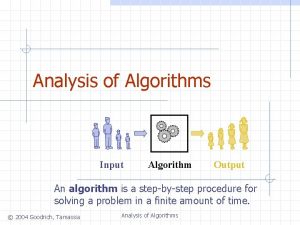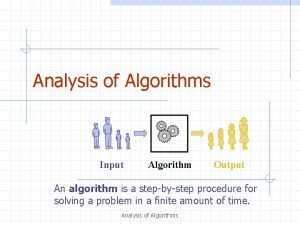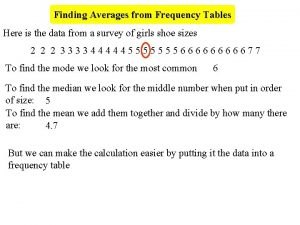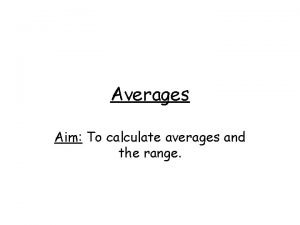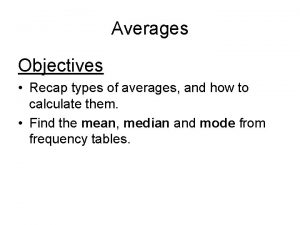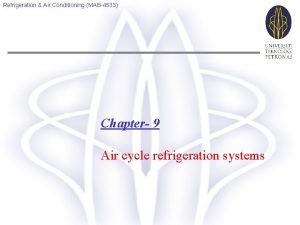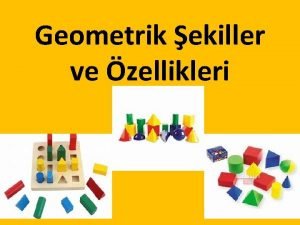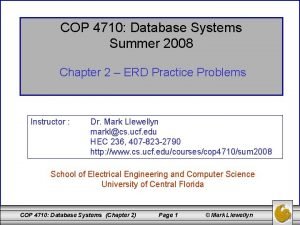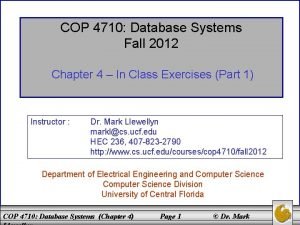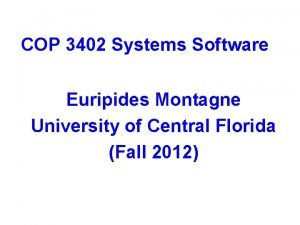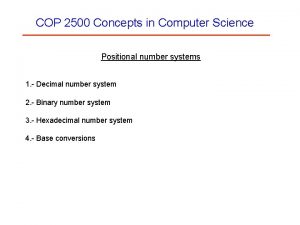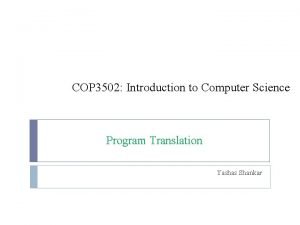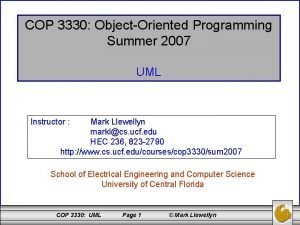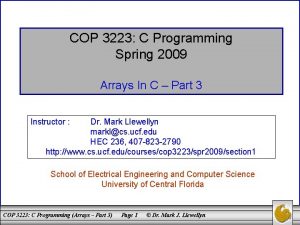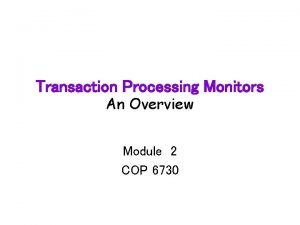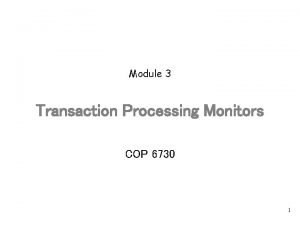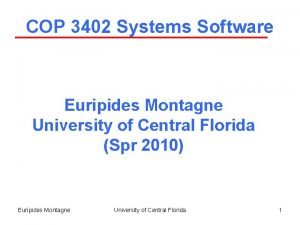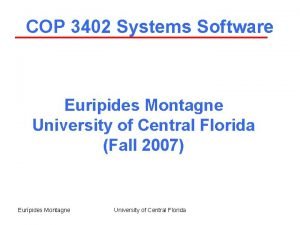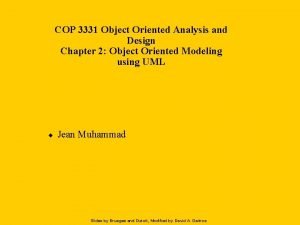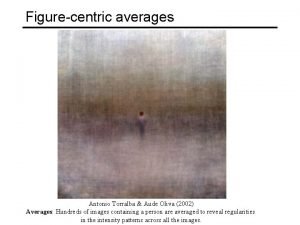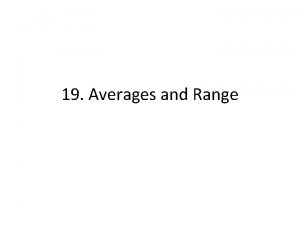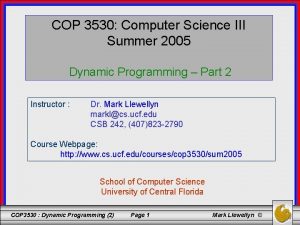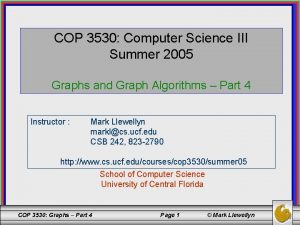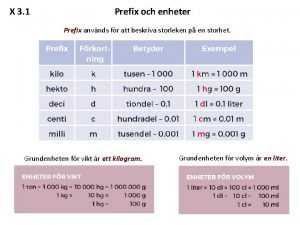Week 2 COP 3530 Prefix Averages Method 1






















































- Slides: 54

Week 2 COP 3530

Prefix Averages (Method 1) • The following algorithm computes prefix averages in quadratic time by applying the definition Algorithm prefix. Averages 1(X, n) Input array X of n integers Output array A of prefix averages of X #operations A new array of n integers n for i 0 to n 1 do n s X[0] n for j 1 to i do 1 + 2 + …+ (n 1) s s + X[j] 1 + 2 + …+ (n 1) A[i] s / (i + 1) n return A 1 run time T(n) = (c 1 n 2+c 2 n)

Prefix Averages (Method 2) Algorithm prefix. Averages 2(X, n) Input array X of n integers Output array A of prefix averages of X A new array of n integers s 0 for i 0 to n 1 do s s + X[i] A[i] s / (i + 1) return A #operations run time T(n) = (c 3 n+c 4) n 1 n n n 1

Tools: Asymptotic Notation • Algorithm 1: T(n) = (c 1 n 2+c 2 n). The quadratic growth of the running time T(n) is an intrinsic property of algorithm prefix. Averages 1 T(n) = O(n 2) • Algorithm 2: T(n) = (c 3 n+c 4). The linear growth of the running time T(n) is an intrinsic property of algorithm prefix. Averages 2 T(n) = O(n)

Big-Oh Rules 1. Drop lower-order terms 2. Drop constant factors Ø If is T(n) a polynomial of degree d, then T(n) is O(nd), i. e. , ex: 7 n-3 is O(n) 3 log n + log n is O(log n) 8 n 2 log n + 5 n 2 + n is O(n 2 log n)

Asymptotic Notation • Big-Oh, O(f(n)) : Asymptotic upper bound – given functions T(n) and f(n), T(n) is O(f(n)) if and only if there are positive constants c and n 0 such that T(n) ≤ c f(n) for n ≥ n 0

“Big Oh” Example: 2 n+6 is O(n) For functions T(n) and f(n) (to the right) there are positive constants c and n 0 such that: T(n)≤c f(n) for n ≥ n 0 cf(n) = 3 n T(n) = 2 n+6 f(n) = n conclusion: 2 n+6 is O(n). n

Another Example T(n) = n 2 On the other hand… n 2 is not O(n) because there is no c and n 0 such that: n 2 ≤ cn for n ≥ n 0 (As the graph to the right illustrates, no matter how large a c is chosen there is an n big enough that n 2>cn ). c 2 f(n) = 3 n c 1 f(n) = 2 n f(n) = n n

Big-Oh Examples 7 n-2 is O(n) need c > 0 and n 0 1 such that 7 n-2 c • n for n n 0 this is true for c = 7 and n 0 = 1 n 3 n 3 + 20 n 2 + 5 is O(n 3) need c > 0 and n 0 1 such that 3 n 3 + 20 n 2 + 5 c • n 3 for n n 0 this is true for c = 4 and n 0 = 21 n 3 log n + log log n is O(log n) need c > 0 and n 0 1 such that 3 log n + log n c • log n for n n 0 this is true for c = 4 and n 0 = 2

Asymptotic Notation (cont. ) • Caution: It is correct to say “ 2 n + 6” is O(n 3)” However, a better statement is “ 2 n + 6” is O(n)”, that is, one should make the approximation as tight as possible

Asymptotic Notation (cont. ) • Special classes of algorithms: Constant: logarithmic: linear: quadratic: polynomial: exponential: O(1) O(log n) O(n 2) O(nk), k ≥ 1 O(an), n > 1 • “Relatives” of the Big-Oh – (f(n)): Big Omega--asymptotic lower bound – (f(n)): Big Theta--asymptotic tight bound – o(f(n)): little oh--asymptotic less than

Asymptotic Notation (cont. ) • Big Omega, (f(n)): asymptotic lower bound – given functions T(n) and f(n), T(n) is (f(n)) if and only if there are positive constants c and n 0 such that T(n) c f(n) for n ≥ n 0 example: 3 log n + log n is (log n) proof: 3 log n + log n 3 log n for n 2

Asymptotic Notation (cont. ) • Big Theta, (f(n)): asymptotic tight bound – given functions T(n) and f(n), T(n) is (f(n)) if T(n) is O(f(n)) and T(n) is (f(n)). or in other words – there exist positive constants c 1 and c 2 and n 0 such that c 1 f(n) ≤ T(n) ≤ c 2 f(n) example: 3 log n + log n is (log n) proof: 3 log n + log n ≤ 4 log n for n 2 O(log n) 3 log n + log n 3 log n for n 2 (log n)

Asymptotic Notation (cont. ) • little oh, o(f(n)): asymptotic less than – given functions T(n) and f(n), T(n) is o(f(n)) if for any constants c > 0, there exists constant n 0 > 0 such that T(n) < c f(n) for n ≥ n 0

Tools: amortization

An Extendable Array Step I. A B Step III. A

An Extendable Array Algorithm push(a): input item a //, array A //output array A with a appended if size() = N then B new array of length f(N) for i 0 to N - 1 B[i] A[i] A B N f(N) t=t+1 A[t] = a //return A • How large should the new array be? – tight strategy (add a constant): f(N) = N + c – growth strategy (double up): f(N) = 2 N

Analyzing Extendable Array Tight vs. Growth Strategies • To compare the two strategies, we use the following cost model: OPERATION regular push operation: special push operation: create an array of size f(N), copy N elements, and add one element RUN TIME 1 N+1

Analyzing Extendable Array Growth Strategy growth strategy (double up): f(N) = 2 N OPERATION special push operation: create an array of size 2 N, copy N elements, and add one element regular push operation: for the next N 1 elements Total time for N element addition RUN TIME N +1 N 1 2 N

Performance of the Tight Strategy tight strategy (constant increment): f(N) = N+C OPERATION special push operation: create an array of size N+C, copy N elements, and add one element regular push operation: for the next C 1 elements Total time for C element addition Growth strategy wins!! RUN TIME N +1 C 1 N+C

Tools: Proof by Induction – Proof of Statement S(n) for all n 1 • Step I: Show the base case. say: S(k) is true for k=1 • Step II: Show that if S(k) is true for 1 k n, then S(n+1) is true.

Proof by Induction – Proof by Induction • ex: Proof: Step II:

Math Fundamentals (continued) Step II: Proof complete.

Lab Quiz 2

Math Fundamentals (continued) • Logarithms: – definition: –

Merge Sort 7 2 9 4 2 4 7 9 7 2 2 7 7 7 2 2 9 4 4 9 9 9 4 4

Merge-Sort • Merge-sort on an input sequence S with n elements consists of three steps: – Divide: partition S into two sequences S 1 and S 2 of about n/2 elements each – Recur: recursively sort S 1 and S 2 – Conquer: merge S 1 and S 2 into a unique sorted sequence Algorithm merge. Sort(S, C) Input sequence S with n elements, comparator C Output sequence S sorted according to C if S. size() > 1 (S 1, S 2) partition(S, n/2) merge. Sort(S 1, C) merge. Sort(S 2, C) S merge(S 1, S 2)

Merging Two Sorted Sequences • The conquer step of merge-sort consists of merging two sorted sequences A and B into a sorted sequence S containing the union of the elements of A and B • Merging two sorted sequences, each with n/2 elements and implemented by means of a doubly linked list, takes O(n) time Algorithm merge(A, B) Input sequences A and B with n/2 elements each Output sorted sequence of A B S empty sequence while A. is. Empty() B. is. Empty() if A. first(). element() < B. first(). element() S. insert. Last(A. remove(A. first())) else S. insert. Last(B. remove(B. first())) while A. is. Empty() S. insert. Last(A. remove(A. first())) while B. is. Empty() S. insert. Last(B. remove(B. first())) return S

Merge-Sort Tree • An execution of merge-sort is depicted by a binary tree – each node represents a recursive call of merge-sort and stores • unsorted sequence before the execution and its partition • sorted sequence at the end of the execution – the root is the initial call – the leaves are calls on subsequences of size 0 or 1 7 2 7 9 4 2 4 7 9 2 2 7 7 7 2 2 9 4 4 9 9 9 4 4

Execution Example • Partition 7 2 9 4 3 8 6 1 1 2 3 4 6 7 8 9 7 2 9 4 2 4 7 9 7 2 2 7 7 7 2 2 3 8 6 1 1 3 8 6 9 4 4 9 9 9 4 4 3 8 3 3 8 8 6 1 1 6 6 6 1 1

Execution Example (cont. ) • Recursive call, partition 7 2 9 4 3 8 6 1 1 2 3 4 6 7 8 9 7 2 9 4 2 4 7 9 7 2 2 7 7 7 2 2 3 8 6 1 1 3 8 6 9 4 4 9 9 9 4 4 3 8 3 3 8 8 6 1 1 6 6 6 1 1

Execution Example (cont. ) • Recursive call, partition 7 2 9 4 3 8 6 1 1 2 3 4 6 7 8 9 7 2 9 4 2 4 7 9 7 2 2 7 7 7 2 2 3 8 6 1 1 3 8 6 9 4 4 9 9 9 4 4 3 8 3 3 8 8 6 1 1 6 6 6 1 1

Execution Example (cont. ) • Recursive call, base case 7 2 9 4 3 8 6 1 1 2 3 4 6 7 8 9 7 2 9 4 2 4 7 9 7 2 2 7 7 7 2 2 3 8 6 1 1 3 8 6 9 4 4 9 9 9 4 4 3 8 3 3 8 8 6 1 1 6 6 6 1 1

Execution Example (cont. ) • Recursive call, base case 7 2 9 4 3 8 6 1 1 2 3 4 6 7 8 9 7 2 9 4 2 4 7 9 7 2 2 7 7 7 2 2 3 8 6 1 1 3 8 6 9 4 4 9 9 9 4 4 3 8 3 3 8 8 6 1 1 6 6 6 1 1

Execution Example (cont. ) • Merge 7 2 9 4 3 8 6 1 1 2 3 4 6 7 8 9 7 2 9 4 2 4 7 9 7 2 2 7 7 7 2 2 3 8 6 1 1 3 8 6 9 4 4 9 9 9 4 4 3 8 3 3 8 8 6 1 1 6 6 6 1 1

Execution Example (cont. ) • Recursive call, …, base case, merge 7 2 9 4 3 8 6 1 1 2 3 4 6 7 8 9 7 2 9 4 2 4 7 9 7 2 2 7 7 7 2 2 3 8 6 1 1 3 8 6 9 4 4 9 9 9 4 4 3 8 3 3 8 8 6 1 1 6 6 6 1 1

Execution Example (cont. ) • Merge 7 2 9 4 3 8 6 1 1 2 3 4 6 7 8 9 7 2 9 4 2 4 7 9 7 2 2 7 7 7 2 2 3 8 6 1 1 3 8 6 9 4 4 9 9 9 4 4 3 8 3 3 8 8 6 1 1 6 6 6 1 1

Execution Example (cont. ) • Recursive call, …, merge 7 2 9 4 3 8 6 1 1 2 3 4 6 7 8 9 7 2 9 4 2 4 7 9 7 2 2 7 7 7 2 2 3 8 6 1 1 3 6 8 9 4 4 9 9 9 4 4 3 8 3 3 8 8 6 1 1 6 6 6 1 1

Execution Example (cont. ) • Merge 7 2 9 4 3 8 6 1 1 2 3 4 6 7 8 9 7 2 9 4 2 4 7 9 7 2 2 7 7 7 2 2 3 8 6 1 1 3 6 8 9 4 4 9 9 9 4 4 3 8 3 3 8 8 6 1 1 6 6 6 1 1

Analysis of Merge-Sort • The height h of the merge-sort tree is O(log n) – at each recursive call we divide in half the sequence, • The overall amount or work done at the nodes of depth i is O(n) – we partition and merge 2 i sequences of size n/2 i – we make 2 i+1 recursive calls • Thus, the total running time of merge-sort is O(n log n) depth #seqs size 0 1 n 1 2 n/2 i 2 i n/2 i … … …

Tools: Recurrence Equation Analysis • The conquer step of merge-sort consists of merging two sorted sequences, each with n/2 elements and implemented by means of a doubly linked list, takes at most bn steps, for some constant b. • Likewise, the basis case (n < 2) will take at b most steps. • Therefore, if we let T(n) denote the running time of merge-sort: • We can therefore analyze the running time of merge-sort by finding a closed form solution to the above equation. – That is, a solution that has T(n) only on the left-hand side.

The Recursion Tree • Draw the recursion tree for the recurrence relation and look for a pattern: time depth T’s size 0 1 n bn 1 2 n/2 bn i 2 i n/2 i bn … … Total time = bn + bn log n (last level plus all previous levels)

Iterative Substitution • In the iterative substitution, or “plug-and-chug, ” technique, we iteratively apply the recurrence equation to itself and see if we can find a pattern: • Note that base, T(n)=b, case occurs when 2 i=n. That is, i = log n. • So, • Thus, T(n) is O(n log n).

Guess-and-Test Method • In the guess-and-test method, we guess a closed form solution and then try to prove it is true by induction: • Guess: T(n) < cn log n. • Wrong: we cannot make this last line be less than cn log n

Guess-and-Test Method, Part 2 • Recall the recurrence equation: • Guess #2: T(n) < cn log 2 n. – if c > b. • So, T(n) is O(n log 2 n). • In general, to use this method, you need to have a good guess and you need to be good at induction proofs.

Master Method • Many divide-and-conquer recurrence equations have the form: • The Master Theorem:

Master Method, Example 1 • The form: • The Master Theorem: • Example: Solution: logba=2, so case 1 says T(n) is O(n 2).

Master Method, Example 2 • The form: • The Master Theorem: • Example: Solution: logba=1, so case 2 says T(n) is O(n log 2 n).

Master Method, Example 3 • The form: • The Master Theorem: • Example: Solution: logba=0, so case 3 says T(n) is O(n log n).

Master Method, Example 4 • The form: • The Master Theorem: • Example: Solution: logba=3, so case 1 says T(n) is O(n 3).

Master Method, Example 5 • The form: • The Master Theorem: • Example: Solution: logba=2, so case 3 says T(n) is O(n 3).

Master Method, Example 6 • The form: • The Master Theorem: • Example: (binary search) Solution: logba=0, so case 2 says T(n) is O(log n).

Master Method, Example 7 • The form: • The Master Theorem: • Example: (heap construction) Solution: logba=1, so case 1 says T(n) is O(n).

Iterative “Proof” of the Master Theorem • Using iterative substitution, let us see if we can find a pattern: • We then distinguish the three cases as – The first term is dominant – Each part of the summation is equally dominant – The summation is a geometric series
 Cop 3530
Cop 3530 Prefix averages
Prefix averages Prefix averages
Prefix averages Good cop bad cop interrogation
Good cop bad cop interrogation Cop 1 cop 2
Cop 1 cop 2 Gtr 3530
Gtr 3530 Csae 3530
Csae 3530 Week by week plans for documenting children's development
Week by week plans for documenting children's development Mean from a grouped frequency table worksheet
Mean from a grouped frequency table worksheet Averages from frequency tables
Averages from frequency tables Averages from a grouped frequency table
Averages from a grouped frequency table How to find the mean of a frequency table
How to find the mean of a frequency table How to.calculate frequency
How to.calculate frequency Comparing averages worksheet
Comparing averages worksheet Moving averages gcse
Moving averages gcse Averages worksheet
Averages worksheet Types of averages
Types of averages Dr frost frequency tables
Dr frost frequency tables Symposium method of teaching
Symposium method of teaching Cop of refrigerator
Cop of refrigerator Limitations of reversed carnot cycle
Limitations of reversed carnot cycle Audit cop
Audit cop Refrigeration cycle ts diagram
Refrigeration cycle ts diagram üçgen prizmaya benzeyen
üçgen prizmaya benzeyen Polly cop
Polly cop Cop 4910
Cop 4910 Cop 4710
Cop 4710 Cop 4710 ucf
Cop 4710 ucf Euripides montagne
Euripides montagne Cop2500
Cop2500 Cop 2500
Cop 2500 Esempio calcolo cop pompa di calore
Esempio calcolo cop pompa di calore What is computer memory
What is computer memory Brooklyn cop
Brooklyn cop Audit cop
Audit cop Cop 16
Cop 16 Snow cop
Snow cop Cop 5725
Cop 5725 Cop3502
Cop3502 Cop 3330 ucf
Cop 3330 ucf Cop 3330 fsu
Cop 3330 fsu Cop 3223
Cop 3223 Transaction processing monitor
Transaction processing monitor Okul sağlığı yönetim ekibi üye listesi (ek 2a)
Okul sağlığı yönetim ekibi üye listesi (ek 2a) Transaction processing monitors
Transaction processing monitors çöp atmak yasak
çöp atmak yasak Cop connect
Cop connect Cop 4910
Cop 4910 Cop 4600
Cop 4600 Cop 3402
Cop 3402 Cop 3402
Cop 3402 Cop 3331
Cop 3331 Cop 3331
Cop 3331 Cop 2800
Cop 2800 Cop 2800
Cop 2800

